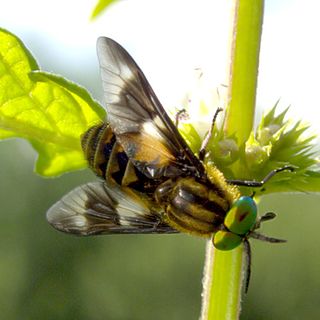
The skimmers or perchers and their relatives form the Libellulidae, the largest dragonfly family in the world. It is sometimes considered to contain the Corduliidae as the subfamily Corduliinae and the Macromiidae as the subfamily Macromiinae. Even if these are excluded, there still remains a family of over 1000 species. With nearly worldwide distribution, these are almost certainly the most often seen of all dragonflies.
Tetracapsuloides bryosalmonae is a myxozoan parasite of salmonid fish. It is the only species currently recognized in the monotypic genus Tetracapsuloides. It is the cause of Proliferative Kidney Disease (PKD), one of the most serious parasitic diseases of salmonid populations in Europe and North America that can result in losses of up to 90% in infected populations.

Salvelinus is a genus of salmonid fish often called char or charr; some species are called "trout". Salvelinus is a member of the subfamily Salmoninae within the family Salmonidae. The genus has a northern circumpolar distribution, and most of its members are typically cold-water fish that primarily inhabit fresh waters. Many species also migrate to the sea.

Tube-dwelling anemones or ceriantharians look very similar to sea anemones but belong to an entirely different subclass of anthozoans. They are solitary, living buried in soft sediments. Tube anemones live inside and can withdraw into tubes, which are composed of a fibrous material made from secreted mucus and threads of nematocyst-like organelles known as ptychocysts. Within the tubes of these ceriantharians, more than one polyp is present, which is an exceptional trait because species that create tube systems usually contain only one polyp per tube. Ceriantharians were formerly classified in the taxon Ceriantipatharia along with the black corals but have since been moved to their own subclass, Ceriantharia.

The superorder Elopomorpha contains a variety of types of fishes that range from typical silvery-colored species, such as the tarpons and ladyfishes of the Elopiformes and the bonefishes of the Albuliformes, to the long and slender, smooth-bodied eels of the Anguilliformes. The one characteristic uniting this group of fishes is they all have leptocephalus larvae, which are unique to the Elopomorpha. No other fishes have this type of larvae.
Haemogregarina is a genus of haemoprotozoans, parasitic mainly on cold-blooded vertebrates. They are unicellular organisms which are parasitic in the red blood cells. Haemogregarina infects lower vertebrates as intermediate hosts and leeches.

The Coelopidae or kelp flies are a family of Acalyptratae flies, they are sometimes also called seaweed flies, though both terms are used for a number of seashore Diptera. Fewer than 40 species occur worldwide. The family is found in temperate areas, with species occurring in the southern Afrotropical, Holarctic, and Australasian regions.

Carnivoramorpha is a clade of mammals that includes the modern order Carnivora and its extinct stem-relatives.

Members of the Monoblepharidomycetes have a filamentous thallus that is either extensive or simple and unbranched. They frequently have a holdfast at the base. In contrast to other taxa in their phylum, some reproduce using autospores, although many do so through zoospores. Oogamous sexual reproduction may also occur.

Superfamily Tabanoidea are insects in the order Diptera.

Odostomia is the most speciose genus of minute sea snails, pyramidellid gastropod mollusks. This genus is placed in the family Pyramidellidae in the subfamily Odostomiinae. There are several hundred species in this diverse genus
Zatrephes is a genus of moths in the family Erebidae. The genus was erected by Jacob Hübner in 1819. It was formerly considered part of the Arctiidae. It includes the former genus Ennomomima, which is now considered a synonym.
Bothriceps is an extinct genus of stereospondyl temnospondyl. It is a member of the infraorder Trematosauria and is the most basal brachyopomorph known. It is one of the only brachyopomorph that lies outside the superfamily Brachyopoidea, which includes the families Brachyopidae and Chigutisauridae. It shares several similarities to Keratobrachyops, another basal brachyopomorph, and may be closely related to or even synonymous with it.

Isodectes is an extinct genus of dvinosaurian temnospondyl within the family Eobrachyopidae. The genus Saurerpeton, named in 1909, is considered to be a junior synonym of Isodectes.
Eimeriorina is a suborder of phylum Apicomplexa.

Byturidae, also known as Fruitworms, is a very small family of beetles, in the suborder Polyphaga, comprising fewer than 20 species worldwide. The larvae of some species develop in fruits. Byturus unicolor affects species of Rubus and Geum.

Endeostigmata is a suborder of endeostigs in the order Sarcoptiformes, which is in the class Arachnida. There are about ten families in Endeostigmata.
Osmakasaurus is a genus of herbivorous iguanodontian dinosaur. It is a basal iguanodontian which lived during the Early Cretaceous period in what is now Buffalo Gap of South Dakota, United States. It is known from the Chilson Member of the Lakota Formation. This genus was named by Andrew T. McDonald in 2011 and the type species is O. depressus.

Empidinae are a subfamily of empidoid flies. They are mainly predatory flies like most of their relatives, and generally small to medium-sized. Most species are flower visitors and they can be effective pollinators.
Schizocystidae is a genus of parasitic alveolates in the phylum Apicomplexa.












